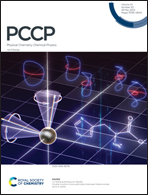The primary photolysis of aqueous carbonate di-anions†
Abstract
We study the primary photolysis dynamics of aqueous carbonate, CO32−(aq), and hydrogen carbonate, HCO3−(aq), when they are excited at λ = 200 nm. The photolysis is recorded with sub-picosecond time resolution using UV pump–Vis probe and UV pump–IR probe transient absorption spectroscopy and interpreted with the aid of density functional theory calculations. When CO32− is excited via single photon absorption at λ = 200 nm, Φ(t = 20 ps) = 82 ± 5% of the excited di-anions either detach an electron or dissociate. The electron detachment takes place from the excited state in t < 1 ps and forms ground state CO3˙− and eaq−. Dissociation occurs from both the electronic ground and excited states of CO32−. Dissociation from the CO32− excited state is assisted by water molecules and forms CO2˙−, OH˙ and OH−. The dissociation occurs both directly from the Franck–Condon region in t < 1 ps and indirectly with a time constant of τ = 13.9 ± 0.5 ps as the excited state relaxes. Dissociation of vibrationally excited CO32− molecules in the electronic ground state is also assisted by water molecules and forms CO2 and two OH− anions. The dissociation and subsequent vibrational relaxation of CO2 occur with a time constant of τ = 10.2 ± 0.5 ps. The residual 1 − Φ(t = 20 ps) = 18 ± 5% of the excited CO32− di-anions return by internal conversion to the equilibrated CO32− ground state with a time constant of τ = 4.0 ± 0.4 ps. The extinction coefficient of aqueous hydrogen carbonate HCO3−(aq) at λ = 200 nm is an order of magnitude smaller than that of carbonate, so even though the hydrogen carbonate anions dominate the carbonate di-anions in the hydrogen carbonate solution, the primary photolysis of hydrogen carbonate is obscured by the photo-products of carbonate. Hence, we are unable to assess the primary photolysis of hydrogen carbonate. However, the weak one-photon absorption facilitates two-photon ionization of water, which forms hydronium, H3O+, cations. The sudden increase in the acidity induced by two-photon ionization protonates the ground state hydrogen carbonate molecules, thus offering a rare spectroscopic glimpse of aqueous carbonic acid.



 Please wait while we load your content...
Please wait while we load your content...